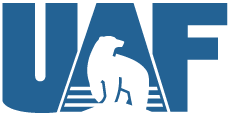Developing electric deck equipment for Alaska kelp farmers

ACEP summer interns Emma Kehoe and Shane Morris set up an electric hauler for testing tension and current.
September 23, 2025
Mariculture in Alaska is at a pivotal point in development. As shellfish and seaweed farming enterprises grow and adapt within Alaska, researchers are working alongside farmers and processors to enable the industry to use sustainable and efficient practices.
Driven in part by warming ocean temperatures and the recent declines in salmon fisheries, Alaska fishers are developing kelp farming operations during the salmon off-season. Kelp farming equipment typically requires a large diesel engine for a comparatively small and intermittent power needed to run it. Electrifying deck equipment has the potential to improve energy efficiency while also reducing noise for workers on deck.
Emma Kehoe, a physics major and human biology and kinesiology minor at Colorado College, joined the Green Energy in Mariculture team this summer as an ACEP intern. Working alongside Chandler Kemp, an assistant professor of sustainable energy at the 51·çÁ÷ąŮÍř Bristol Bay campus and an affiliate researcher with ACEP, Kehoe focused specifically on designing electric deck equipment for kelp farmers.
With the possibility of reducing the kelp industry’s reliance on fossil fuels, Kehoe analyzed kelp hauling data from an operation in Juneau, Alaska. From processing kelp line tension data and further research into the specific needs of the operation, she selected an electric motor, gearbox, hauler and speed controller to pilot test. She then assembled and tested this hauling system in the UA Anchorage power lab so it can be used in the 2026 kelp harvest.
In addition to her work on designing electric deck equipment, Kehoe traveled to Kodiak, Alaska, to learn from kelp farmers and to better quantify energy use within kelp farming and processing. She visited multiple vessels used for kelp harvesting, the, which tests kelp hatchery methods, and the processing plant that currently processes all of the kelp grown in Kodiak. The energy use data Kehoe collected in Kodiak will become part of a green energy plan that GEM will develop, which will be used as an investment guide for the mariculture industry.

ACEP intern Emma Kehoe holds a female king crab in the Alaska Fisheries Science Center Kodiak Laboratory during her field work in Kodiak, Alaska for the Green Energy in Mariculture project.
Kehoe is grateful to have worked with the 51·çÁ÷ąŮÍř and ACEP energy engineers and fishers who are dedicated to creating regenerative practices as this industry is established.
“Seeing the Kodiak kelp community in action showed me how adaptive, collaborative and innovative this industry is,” she said.
This internship was funded by the through the 51·çÁ÷ąŮÍř Center for Innovation, Commercialization and Entrepreneurship and the ACEP Undergraduate Summer Internship program. View the on ACEP’s YouTube channel. For more information on this project, contact Chandler Kemp at ckemp6@alaska.edu.


